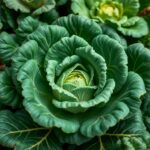When Should You Harvest Garlic: The Ultimate Guide to Timing Your Garlic Harvest

Garlic is a beloved kitchen staple, known for its unique flavor and numerous health benefits. However, achieving the perfect garlic harvest requires more than just planting. Timing is crucial to ensure that your garlic bulbs reach their maximum size and flavor potential. In this ultimate guide, we'll explore the key signs and indicators you need to monitor to determine the optimal time for harvesting garlic. From understanding the growth stages to recognizing when your garlic is ready to be pulled from the ground, this article will equip you with everything you need to know for a successful harvest.
When Should You Harvest Garlic?
The ideal time to harvest garlic is when the lower leaves of the plant begin to turn yellow and brown, typically occurring in mid to late summer, depending on your climate and the variety planted. Generally, you should observe that around one-third of the leaves are still green, which indicates that the bulbs have developed sufficiently underground. If harvested too early, the bulbs may not reach their full size and flavor; however, if left in the ground too long, they can split open, diminishing their storage quality. Monitoring the garlic closely as the harvest time approaches can ensure that you reap a bountiful and healthy crop.
Signs of Maturity
Garlic reaches maturity when the lower leaves start to yellow and die back while the upper leaves remain green. This process typically occurs in the summer months when the plant has fully developed its bulbs. Signs of maturity also include the bulb's size, which can be evaluated through careful examination of the plant; larger bulbs often indicate that they are ready for harvesting.
Timing Based on Climate
The time to harvest garlic can vary significantly based on your climate. In cooler regions, garlic may mature later than in warmer areas; for example, garlic planted in the spring will usually be ready by mid-summer, while fall-planted garlic is often ready to be harvested in late summer. Understanding your local climate can help you determine the correct timing for the harvest.
Impact of Variety
Different varieties of garlic have distinct maturation timelines, which can affect harvest dates. Hardneck garlics usually mature a few weeks earlier compared to softneck types. Knowing the specific variety you are growing can help you assess more accurately when to expect the plant to be ready for harvest.
See also:
Testing the Bulbs
A reliable way to determine if garlic is ready for harvest is through a simple test of the bulbs. Carefully dig up a few bulbs one to two weeks before the expected harvest time to check their size and condition. If they are plump and their skins are still intact, it’s a good sign that they are maturing properly. Monitoring the bulb condition can help you make the best decision about when to harvest.
Post-Harvest Considerations
After harvesting, it's essential to handle the garlic bulbs with care to prevent damage and ensure a longer shelf life. They should be hung in a cool, dry, and well-ventilated area to allow for proper curing, which can take several weeks. Proper post-harvest techniques can greatly affect the garlic's taste and longevity in storage, making this stage an important part of the overall harvest process.
| Sign | Meaning |
|---|---|
| Lower leaves yellowing | Garlic is nearing harvest time. |
| Bulb size | Indicates maturity; larger bulbs are preferable. |
| Yellowing of leaves | Signal of nutrient depletion; time to harvest. |
| Soil conditions | Dry soil can indicate readiness to harvest. |
| Testing bulbs | Direct way to evaluate readiness for harvest. |
Understanding the Signs of Garlic Readiness
Identifying the right time to harvest garlic is crucial, as it can significantly affect both the quality and quantity of your crop. As garlic matures, you will notice several indicators that signal its readiness. The leaves will start to yellow and die back, typically when the lower three to four leaves have turned brown. Another important sign is the size of the bulbs; when they reach their full size and feel firm to the touch, it indicates that they are ready for harvest. Additionally, monitoring the weather conditions is essential, as harvesting during dry periods can help prevent disease and ensure better storage.
Signs of Maturity in Garlic
As garlic approaches maturity, there are specific signs you should look for. The leaves will start turning from vibrant green to yellow, and typically, four to five leaves will be brown by the time it's ready for harvest. The bulbs also achieve their maximum size at this stage, and the outer skins will begin to dry out. Watching for these changes in combination will help ensure your garlic is harvested at its prime, resulting in the best flavor and longest storage potential.
Timing Your Harvest based on Climate
Climate plays a significant role in determining when to harvest garlic. In cooler climates, garlic is usually ready in mid-summer, while in warmer regions, harvest may occur as early as late spring. Factors such as temperature, and rainfall can affect growth rates, and it's crucial to adapt your harvesting time based on local weather conditions. Monitoring how your garlic responds to these climatic elements will enable you to optimize your harvest for the best quality and yield.
See also:
Benefits of Harvesting at the Right Time
Harvesting garlic at the right time can bring several benefits. It maximizes the size and quality of the bulbs, contributing to improved flavor and texture. Additionally, timely harvesting prevents the bulbs from becoming overripe and can minimize issues such as disease and soft rot, which can significantly affect long-term storage. By ensuring that you're harvesting garlic at its peak, you set yourself up for a successful crop that meets your culinary and storage needs.
How to Test Garlic Readiness
To effectively test if your garlic is ready for harvest, start by inspecting the foliage and the bulb. Gently dig around the bulb to check its size— it should feel firm and solid, not mushy. If you're unsure, you may pull one bulb to assess its condition; check for proper cloves formation and ensure the skins are beginning to dry out. This testing method allows you to make a well-informed decision about when to proceed with the full harvest.
Common Mistakes to Avoid When Harvesting Garlic
Many gardeners make common mistakes that can jeopardize their garlic crop. One significant error is harvesting either too early or too late; both can affect bulb quality. Failing to observe the number of yellow leaves or the condition of the bulbs can lead to premature harvesting. Another mistake is not considering weather conditions; harvesting during wet conditions increases the likelihood of rot. Being mindful of these common pitfalls can enhance your overall garlic yield and maintain its quality.
Questions from Our Readers
When is the best time to harvest garlic?
The best time to harvest garlic is typically in late spring or early summer, specifically when the lower leaves begin to turn yellow and brown. This usually occurs about 8 to 10 months after planting, indicating that the bulbs have reached maturity and are ready for harvest.
How can I tell if my garlic is ready to harvest?
You can tell if your garlic is ready to harvest when the bottom leaves start to yellow and die back. Ideally, you want to see about one-third of the leaves still green, which suggests that the bulbs are fully developed without being over-mature.
See also:
What should I do after harvesting garlic?
After harvesting garlic, it's important to cure the bulbs by hanging them in a cool, dry place with good air circulation for about two to three weeks. This process helps to enhance the flavor and extends the storage life of the garlic.
Can I leave garlic in the ground too long?
Yes, leaving garlic in the ground too long can lead to bulb splitting and reduced flavor quality. If you wait too long, the papery skin can break down, which increases the risk of disease and makes the garlic less suitable for long-term storage.

If you want to read more articles like When Should You Harvest Garlic: The Ultimate Guide to Timing Your Garlic Harvest, we recommend you check out our Gardeners category.
Leave a Reply
Related Articles